Christmas Celebration In History From 336 A.D. – 2016

Updated article here:
CHRISTMAS CELEBRATION IN HISTORY FROM 336 A.D.-2017
Many modern and church historians are in agreement that Christ began his ministry during the month of October in 29 A.D. -“Repent, for the Kingdom of Heaven is Near”, during in the 15th year of the Emperor Tiberius’ reign. Second Century Christian scholars, such as Irenaaus, said that Jesus “was beginning to be about thirty years of age” [Against Heresies h, II, xxii, 5]. The generally assumed date range for when John the Baptist was active, based on the reference to the reign of Tiberius in Luke 3:1-2, is from about 28-29 A.D., with Jesus beginning to preach shortly thereafter.
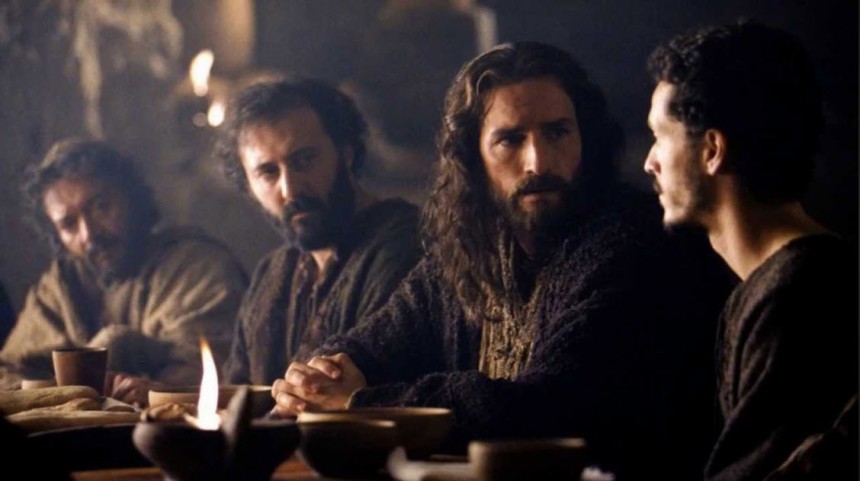
This satisfies the statement in Luke 3:23 “And when He began his ministry, Jesus Himself was about thirty years of age…” Based on the reference in John 2:13 to the Temple being in its 46th year of construction, scholarly estimates for Jesus’ Temple visit in John 2:20 are around 28-29 A.D., when Jesus was “about thirty years of age.” By working backwards from this date, it would appear likely that Jesus was born in 2-3 B.C.E.
The Birth of the King of the Jews and His Star In the East
Herod the Great (74 – 1 B.C.E.) was a Roman client king of Judea, referred to as the Herodian Kingdom. After the birth of Jesus, some astrologers (magi) from Babylon visited Herod to inquire the whereabouts of “the one having been born king of the Jews”, because they had seen his star in the east (or, according to certain translations, at its rising) and therefore wanted to pay him homage (Matthew 2:1-12). Herod, as King of the Jews, was alarmed at the prospect of an usurper. Herod assembled the chief priests and scribes of the people and asked them where the “Anointed One” was to be born. The astrologers answered, “In Beit-Lechem of Y’hudah,” citing the prophesy of the birth of a Jewish king from Micah 5:2, “because the prophet wrote, ‘And you, Beit-Lechem in the land of Y’hudah, are by no means the least among the rulers of Y’hudah; for from you will come a Ruler who will shepherd my people Isra’el.'” (Matthew 2:4-6)
Herod therefore sent the magi to Bethlehem, instructing them to search for the child and, after they had found him, to “report back to me, so that I too may go and worship him”. However, after they had found Jesus, they were warned in a dream not to report back to Herod. Similarly, Joseph was warned in a dream that Herod intended to kill Jesus, so he and his family fled to Egypt. When Herod realized he had been outwitted, he gave orders to kill all boys of the age of two and under in Bethlehem and its vicinity. Joseph and his family stayed in Egypt until Herod’s death, then moved to Nazareth in Galilee to avoid living under Herod’s son and successor Archelaus.
In 4 B.C.E. around that age of 70 years, Herod became very sick with chronic kidney disease complicated by Fourier’s gangrene. Herod’s sons, between whom his kingdom were to be divided, were printing his coins as early as 4 B.C.E. to ensure their succession of rulership in Judea, with Archelaus exercising royal authority during Herod’s final years of rule.
Herod’s Death and Jesus’ Birth
The Roman historian Josephus tells us that Herod died after a lunar eclipse. He gives an account of events between this eclipse and his death. A Lunar Eclipse took place on January 10th, 1 B.C.E., about 18 days after the Eclipse. Jesus therefore most likely born in 3 B.C.E. — as confirmed by Irenaeus, Clement of Alexandria, Tertullian, Africanus, Hippolytus of Rome, Hippolytus of Thebes, Origen, Eusebius, and Epiphanius.
Taking this further, we can speculate on the month of Jesus’ birth based on the conception story of John the Baptist (Luke 1:5-25). John the Baptist was conceived during the period of time Eighth Course of Abijah, which was May 26 to June 1 in 4 B.C.E. (Leviticus 21:16–23). The human gestation period is about 280 days ― nine months and ten days. This indicates that the birth of John the Baptist occurred near March 10th, 3 B.C.E. Jesus was conceived sometime in the sixth month of Elizabeth’s pregnancy (Luke 1:26, 36). Therefore, Jesus was born six months after, near September 11th, 3 B.C.E. [Tishri One on the Jewish calendar] during the Jewish Feast of the Tabernacles, a very holy day in Judaism.
Event Charts of Early Christianity :
- Jesus’ Birth – September 11, 3 B.C.
- Magi Arrive Bearing Gifts – December 25, 2 B.C.
- Herod’s Death – January 28, 1 B.C.
- Tiberius Becomes Emperor of Rome – August 19, 14 A.D.
- Jesus Begins His Ministry – October 18, 29 A.D.
- Crucifixion and Death – April 3, 33 A.D.
- Pentecost – May 24, 33 A.D.
- Destruction of the Second Temple and Jerusalem – August 3, 70 A.D.
The First Christmas Celebration by the Early Christian Church
For the first three centuries of Christianity’s existence, Jesus Christ’s birth wasn’t celebrated at all. The religion’s most significant holidays were Epiphany on January 6, which commemorated the arrival of the Magi after Jesus’ birth, and Easter, which celebrated Jesus’ resurrection. The first Christmas celebration by the early Christian Church occurred 331 years after Christ’s Crucifixion in Jerusalem – April 3rd, 33 A.D. (during the Lunar Eclipse at 5:12 PM LMT) and Pentecost – which is considered to be the inception date of the Roman Catholic Church. In an old list of Roman bishops, compiled in 354 A.D., these words appear for 336 A.D.: “25 Dec.: natus Christus in Betleem Judeae.” Translation: December 25th, Christ born in Bethlehem, Judea.
Pope Julius I, the bishop of Rome (from February 6, 337 to his death in 352), declared the nativity celebration of Christ on December 25th because it coincided with the existing pagan festival honoring Saturn (the Roman God of Agriculture) that began several days before the Winter Solstice.
Horoscope of the First Christmas Celebration – 336 A.D.
Above is the horoscope of the first Christmas celebration that occurred in Rome on December 25th, 336 A.D. during the first Mass upon sunrise 7:30 AM Local Mean Time. In the First Christmas Celebration event horoscope, we note the placement of the Moon in Pisces. Many Christian symbols for Christ use the astrological symbol for Pisces, the fish. The twelve apostles were called the “fishers of men,” and early Christians called themselves “little fishes,” and a code word for Jesus was the Greek word for fish, “Ikhthus.”
We also note from the First Christmas Celebration horoscope, the ingress of Uranus on the cardinal axis at 0 Aries, and the Neptune-Pluto square alignment, both mundane astrological portents that augur Christianity’s remarkable rise to prominence from a tiny persecuted cult to the established religion that would dominate in the medieval West over the next 1,500 years.
The Neptune-Pluto alignment often coincides with profound historical transformations within the collective, that usher in the seeding of a new cultural worldview that sets in motion the destruction of the old one. During the Neptune-Pluto square alignment during the early 4th century, there was a”changing of the Gods”, as powerful archetypal subterranean forces were unleashed that led to the destruction the of the Roman Empire and the death of its Gods, as a nascent underlying matrix emerged based on the metaphysical beliefs and dogma of Christianity, that offered spiritual comfort and the prospect of salvation, decreed by the spiritual authority of the Church, that would later eclipse Roman authority and rule by the early 5th century.
Finally, the First Christmas Celebration by the early Church occurred within 40 years of the precessional shift into the sign of Pisces that occurred in 3rd century in 221 A.D. (based on the Fagan\Bradley Ayanamsa), which was the last year that the Sun last rose in the constellation of Aries in both the tropical and sidereal zodiac at the Spring Equinox. The Edict of Milan, an agreement to treat Christians benevolently within the Roman Empire, occurred in February 312 A.D., a mere 91 years after the precessional shift into the sign of Pisces.
The Celebration of Christmas – From Rome to Constantinople
The celebration of Christmas spread over the next several centuries throughout the Roman Empire, from the Western capital of Rome to the Eastern capital of Constantinople which acted as a gateway between East and West. Christmas was promoted in the Christian East as part of the revival of Nicene Christianity following the death of the pro-Arian Western Roman Emperor Valens at the Battle of Adrianople in 378.
Christmas festivities were introduced in the Eastern Roman Empire at Constantinople in 379, and at Antioch in about 380 AD. After the collapse Western Roman Empire in 411 AD, the celebration of Christmas ceased during the remainder of the 5th century. During the Dark Age (500 – 800 A.D.), Christmas Day was overshadowed by the Feast of the Epiphany (January 6th), which focused on the visit of the magi. However, the medieval church calendar was dominated by Christmas-related holidays.
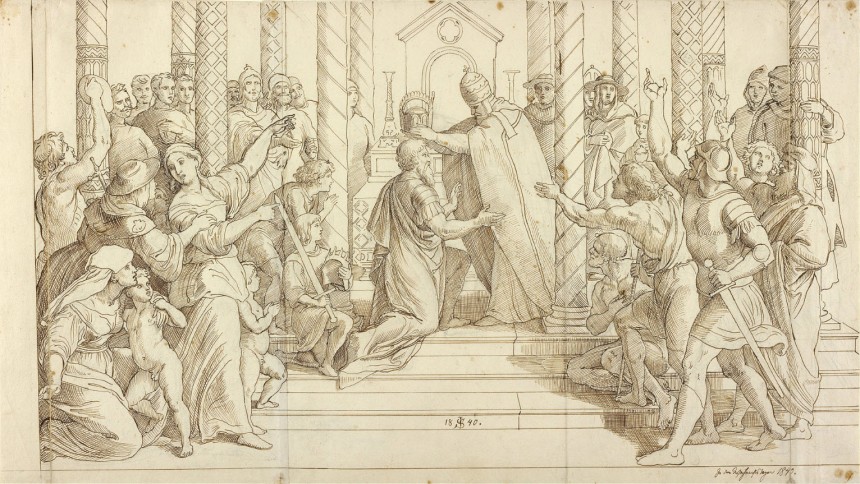
The prominence of Christmas Day increased gradually after Charlemagne was crowned Holy Roman Emperor by the Pope in Rome on Christmas Day in 800 which marked the transition period from the Medieval Dark Age to the Early Middle Age (800-1066).
Also, William the Conqueror, the first King of England, was crowned on Christmas Day 1066, which marked the transition of the Early Middle Age to the High Middle Age (1066 – 1307).
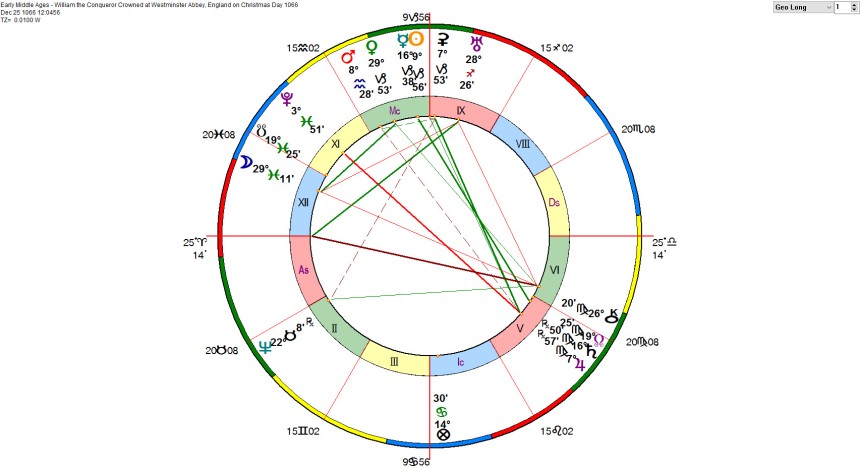
Early Middle Ages – William the Conqueror Crowned at Westminster Abbey, England, on Christmas Day 1066
Christianization of Europe
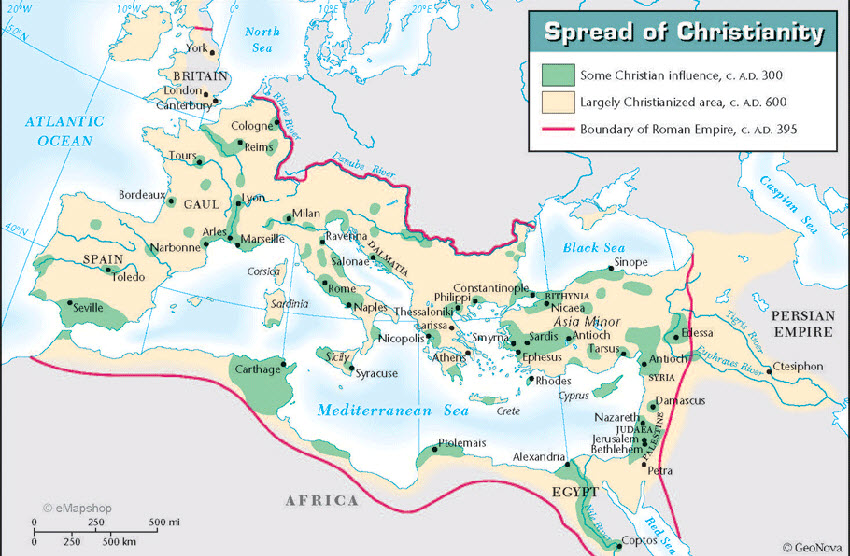
After the disintegration of the Western Roman Empire in 476 A.D., the Christianization of the Germanic peoples began. Many popular customs associated with Christmas developed independently of the celebration of Jesus’ birth, with many elements having origins in pre-Christian festivals that were celebrated around the winter solstice by pagan populations throughout Europe who were later converted to Christianity from 300 – 600 A.D.
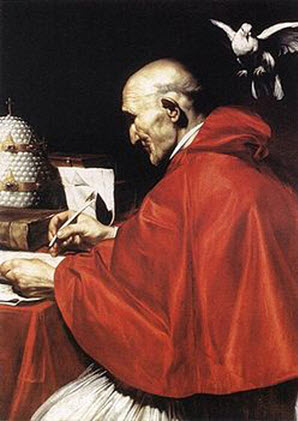
English historian Bede’s Historia ecclesiastica gentis Anglorum contains a letter from Pope Gregory I (Pope from September 3rd, 590 to his death in 604) to Saint Mellitus, who was then on his way to England to conduct missionary work among the pagan Anglo-Saxons. Pope Gregory I, suggested that converting heathens would go easier if they were allowed to retain the outward forms of their traditional pagan practices and traditions, while recasting those traditions spiritually towards the Christian God instead of to their pagan “devils”: “to the end that, whilst some gratifications are outwardly permitted them, they may the more easily consent to the inward consolations of the grace of God.”
Many pre-Christian elements, such as the Yule Log (a specially selected log burned on a hearth as a Christmas tradition in a number of countries in Europe) and the gift giving from the ancient Roman Festival of Saturnalia, became integrated into Christmas over the centuries. The burning of the Yule Log, the decorating of Christmas trees, the eating of ham, the hanging of boughs, holly, mistletoe, etc. are all historically practices associated with Yule.
Church missionaries from Rome found it convenient to provide a Christian reinterpretation of popular pagan holidays such as Yule and allow the celebrations themselves to go on largely unchanged, versus trying to confront and suppress them. The Scandinavian tradition of slaughtering a pig at Christmas (Christmas ham) is probably salient evidence of this. The tradition is thought to be derived from the sacrifice of the boar to the god Freyr at the Yule celebrations. Halloween and aspects of Easter celebrations are likewise assimilated from northern European pagan festivals.
Norway: Jul
The main Jul event for Norwegians is on Julaften on December 24th, the evening of the main feast, is served and gifts are exchanged. Almost all Norwegian breweries produce traditional beer, juleøl, and a special soda, julebrus. Jul dishes are also served on Julebord, where people from work gather around early December to feast and drink alcoholic beverages. Also, seven types of cookies, julekaker, traditionally baked by the mother of the house, are prepared. There is also the Julebukk or Nyttårsbukk tradition of which it is common for children to pay visits to neighbors where they are given candy, nuts, and clementines. The children may dress up and go out every day between Juleaften and New Year’s Eve. Adults also dress up later in the evening and Drammebukk by paying visits to neighbors in much the same way as the children, but the main difference is that adults are given drinks instead of candy. (Source: Wikipedia)
Denmark: Jul
In Denmark, Jul is celebrated on December 24th, which is referred to as Juleaftensdag. An elaborate dinner is eaten with the family consisting of either roast pork, roast duck or roast goose with potatoes, red cabbage and gravy. For dessert rice pudding is served, traditionally with an almond hidden inside. The lucky finder of this almond is entitled to a small gift. After the meal is complete, the family gather around the Juletræ and sing Christmas carols. When the singing is complete, the children often hand out the presents. They are opened and this is followed by candy, chips, different kind of nuts, clementines and sometimes the traditionally Gløgg (mulled and spiced wine with almonds and raisins), which is served hot in small cups. (Source: Wikipedia)
Sweden: Jul
As in many other countries in northern Europe, Jultomten brings the presents on julafton (Yule Eve), December 24th, the day generally thought of as the main Jul day. Many swedes watch Kalle Anka och hans vänner, a compilation of Disney films. Almost all Swedish families celebrate with a julbord. The common part of almost all julbord is the julskinka (baked ham). The julbord is served with beer or julmust and snaps, the dishes of the julbord may vary throughout Sweden. Businesses traditionally invite their employees to a julbord dinner or lunch the weeks beforehand, and people go out privately to restaurants offering julbord during December, as well. Swedes also enjoy glögg like in many other countries of Scandinavia. After the julbord, the presents are distributed, either by Jultomten or a family member, and usually from a sack or from under the Christmas tree where they have been laying all day or for several days. In older days a julbock (yule goat) was an alternative to Jultomten, nowadays it is used as an ornament, ranging from sizes of 10 cm to huge constructions like the Gävle goat. The next morning, some people attend the julotta, an early morning church service on jul day. (Source: Wikipedia)
Shetland Islands: Yules
In the Shetland Islands of Scotland the Yules are considered to last a month beginning on December 18th and ending January 18th. The main Yules celebration occurs in between, on December 31st. The rest of Scotland eventually adopted “Hogmanay” (the name of the New Year’s presents) as the festival’s name. (Source: Wikipedia)
Neopaganism
As forms of Neopaganism can be quite different and have very different origins, these representations can vary considerably despite the shared name. Some celebrate in a manner as close as possible to how they believe that the Ancient Germanic pagans observed the tradition, while others observe the holiday with rituals culled from numerous other unrelated sources, Germanic culture being only one of the sources used. (Source: Wikipedia)
Germanic neopaganism: Yule
In Germanic Neopagan sects, Yule is celebrated with gatherings that often involve a meal and gift giving. Further attempts at reconstruction of surviving accounts of historical celebrations are often made, a hallmark being variations of the traditional. However, it has been pointed out that this is not really reconstruction as these traditions never died out – they have merely removed the superficial Christian elements from the celebrations. Groups such as the Asatru Folk Assembly in the U.S. recognize the celebration as lasting for 12 days, beginning on the date of the winter solstice. (Source: Wikipedia)
Wicca: Yule
In general, many Wiccan-based sects favor a plethora of sources on winter solstice holidays to recreate a type of Yule holiday. While the name “Yule” is used, it is not a reconstruction of the historical holiday. Wreaths, Yule logs, decoration of trees, decorating with mistletoe, holly, and ivy, exchanges of presents, and even wassailing are incorporated and regarded as sacred. The return of the Sun as Frey is commemorated in some groups. In most Wiccan sects, this holiday is also celebrated as the rebirth of the Great God, who is viewed as the newborn solstice sun. (Source: Wikipedia)
Wassail: Yuletide Beverage
Wassail is a hot beverage of mulled punch associated with Yuletide. Historically, the drink was a mulled cider made with sugar, cinnamon, ginger, and nutmeg and topped with slices of toast. Modern recipes begin with a base of wine, fruit juice, or mulled ale, sometimes with brandy or sherry added. Apples or oranges are often added to the mix. While the beverage typically served as “wassail” at modern holiday feasts with a medieval theme most closely resembles mulled cider, historical wassail drinks were completely different, more likely to be mulled beer, or mead. Sugar, ale, ginger, nutmeg, and cinnamon would be placed in a bowl, heated, and topped with slices of toast. Some recipes also call for beaten eggs to be tempered into the drink. (Source: Wikipedia)
The Wassail Song (traditional English)
Here we come a-wassailing
among the leaves so green.
Here we come a-wand’ring
so fair to be seen.
Love and joy come to you,
and to all your wassail, too,
may the gods bless you, and send you
a Happy New Year,
the gods send you a Happy New Year.
Good master and good mistress,
as you sit beside the fire,
pray think of us poor children
who wander through the mire.
Love and joy come to you,
and to all your wassail, too,
may the gods bless you, and send you
a Happy New Year,
the gods send you a Happy New Year.
Bring us out a table fine
and spread it out with cloth;
Bring us out a farmer’s cheese,
and some of your Christmas loaf.
Love and joy come to you,
and to all your wassail, too,
may the gods bless you, and send you
a Happy New Year,
the gods send you a Happy New Year.
Druids: The Solstice, Mistletoe, and the Oak King Battling Holly King
On the Solstice, druids would gather by the oldest Mistletoe clad Oak. The Chief Druid would make his way to the mistletoe to be cut whilst below, other Druids would hold open a sheet to catch it, making sure none of it touched the ground. With his Golden Sickle, and in one chop, the Chief Druid would remove the mistletoe, to be caught below.
The early Christian church banned the use of mistletoe because of its association with Druids. The holiday is observed in a manner that commemorates the death of the Holly King identified with the wren bird (symbolizing the old year and the shortened sun) at the hands of his son and successor, the robin redbreast Oak King (the new year and the new sun that begins to grow) (Farrar & Farrar [1989] 1998: 35-38). The Battle of the Holly King and Oak King is re-enacted at rituals, both open and closed. The battle is usually in the form of words but it has been known for there to be sword battles. The scene above depicts the Oak King’s final strike against his brother, the Holly King and to ultimate victory, at least for the next six months. (Source: Wikipedia)
Eggnog: Post-Revolutionary America

In the early days of the United States, celebrating Christmas was considered a British custom and fell out of style following the American Revolution (1775-1783). It wasn’t until 1870 that Christmas became a federal holiday. However, Eggnog is traditionally consumed throughout the United States from American Thanksgiving through the end of the Christmas seasons every year. The word eggnog seems to have been an American invention, first appearing in the late 1700s. However, no one is sure where it came from. It may have evolved from nog, an old English name for a variety of strong beer, or from noggin, a small wooden mug used to serve drinks in taverns.
In Britain, the drink was popular mainly among the aristocracy. Those who could get milk and eggs mixed it with brandy, Madeira, or sherry to make a drink similar to modern alcoholic egg nog. The drink crossed the Atlantic to the British colonies during the early 18th century.
George Washington, the Commander-in-Chief of the Continental Army during the American Revolutionary War, one of the Founding Fathers, and first President of the United States, was a fan of eggnog. Washington had his own eggnog recipe and ordered his servants that it be prepared and served according to his specifications during his Christmas celebration events at his home and plantation at Mount Vernon and during his Presidency (1789-1797).
8:00pm – Guest arrival with eggnog served and dancing
10:00pm – Seated supper
Midnight – Dancing resumes
5:00am – The last guests leave
The first President’s brew wasn’t an eggnog for the fainthearted, given its alcohol content (Note the Mars-Jupiter Conjunction):
George Washington’s Eggnog Recipe
One quart of heavy cream
One quart of milk
One dozen tablespoons sugar
One pint brandy
12 Eggs
½ pint rye whiskey
½ pint Jamaica rum
¼ pint sherry
Directions: Mix the liquor first, then separate the yolks and whites of eggs, add sugar to beaten yolks, mix well. Add milk and cream, slowly beating. Beat whites of eggs until stiff and fold slowly into mixture. Let sit in a cold place for several (3-5) days before serving. The recipe ends with a congenial “Taste frequently.” Nobody could tell a lie after having a few cups.
Great Britain: The English Christmas Revival
A Christmas Carol is a novella by Charles Dickens (1815 – 1870), first published in London by Chapman & Hall publishing company on December 19th, 1843. A Christmas Carol met with instant success and critical acclaim, telling a story of a bitter cold-hearted old miser named Ebeneezer Scrooge and his psycho-spiritual death-rebirth transformation into a gentler, kindlier man after visitations by the three Ghosts of Christmas (Ghost of Christmas Past, Ghost of Christmas Present, and the Ghost of Christmas Yet to Come) and the ghost of his former business partner Jacob Marley. The tale of Scrooge’s spiritual redemption since Christmas 1843 has become a defining tale of the Christmas holiday among the eighty-eight English-speaking nations throughout the world.
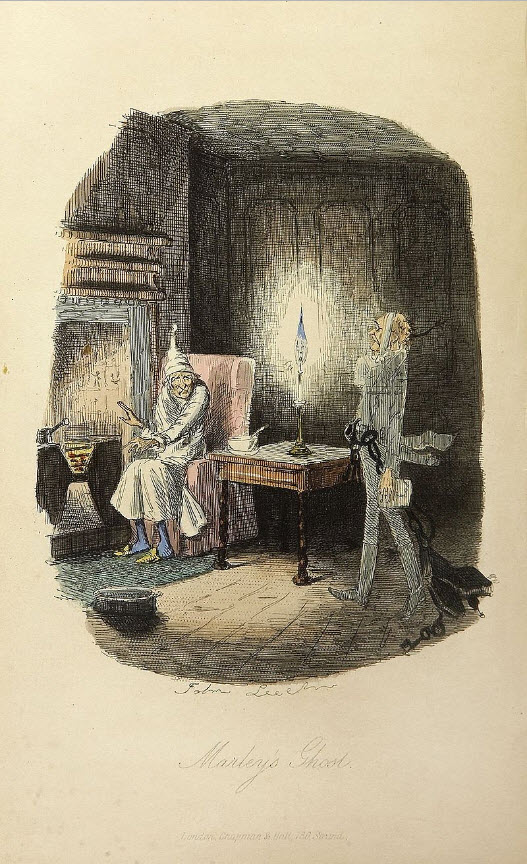
The book was written at a time when the British were examining and exploring Christmas traditions from the past as well as new customs such as Christmas Cards and Christmas Trees. Also, Christmas Carol singing took a new lease of life during this time. Dickens, being perfectly in-tune with British culture, published his story at precisely the right moment (Note: Mars-Jupiter-Neptune Conjunction Dec 1st, 1843), which reflected a widespread bourgeoisie interest and desire to reinvigorate Christmas and its ancient customs. Since 1843, A Christmas Carol remains popular—having never been out of print —and has been adapted many times to film, stage, opera, and other media. (Source: Wikipedia)
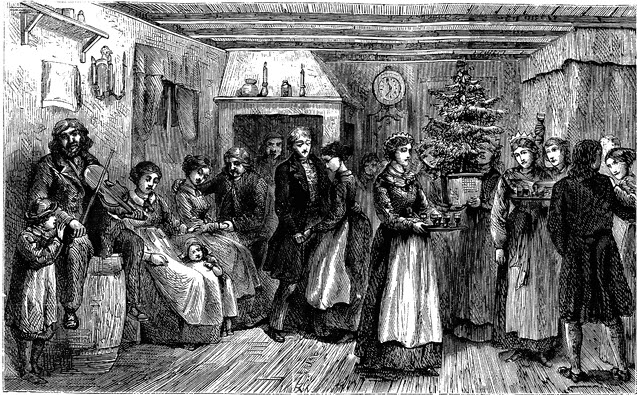
The United States: The Globalization of Christmas
On June 26th, 1870, Christmas was formally declared a United States federal holiday. Christmas is the most widely celebrated holiday of the year in the United States, commonly celebrated by Christians and non-Christians alike with various traditions.

The first electric lights on a family tree were used in 1894 during the presidency of Grover Cleveland. It was placed in the second floor Oval Room of the White House. The Cleveland Family tree decorated with red, white and blue electric light bulbs, delighted the president’s young daughters.
In the 20th century during the onset of the Industrial Revolution (circa 1900 during the Uranus-Pluto Opposition), Christmas began to become peak selling season for retailers in the United States, along with many nations around the world. Sales increase dramatically as people purchased gifts, decorations, and supplies to celebrate. In the United States, the “Christmas shopping season” traditionally starts at the commencement of the annual Macy’s Thanksgiving Day Parade at noon, with the arrival of Santa Claus who always closes out the parade, welcomed into Herald Square in Manhattan. The parade is presented and sponsored by the U.S.-based department store chain Macy’s.
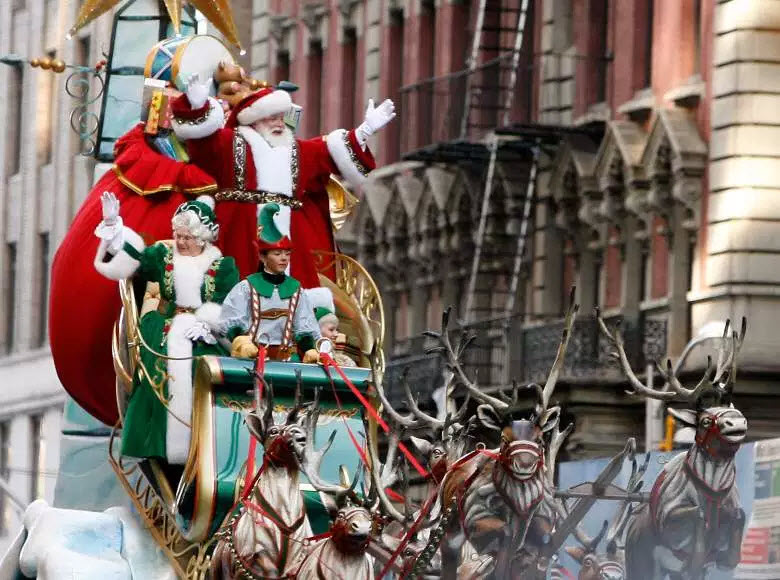
During the Roaring ’20s – a period of dramatic economic expansion and social experimentation – many of Macy’s department store employees were first-generation European immigrants who quickly reached middle-class status and were proud of their new American heritage, and sought to celebrate the American holiday season of Thanksgiving with the type of festival their parents had loved in Europe. The tradition started in 1924 at 9:00 am in Manhattan, New York (Note Jupiter in Sagittarius rising in the Event Horoscope). With an audience of over 250,000 people, the parade was such a success that Macy’s declared it would become an annual event.



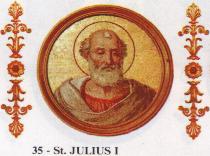
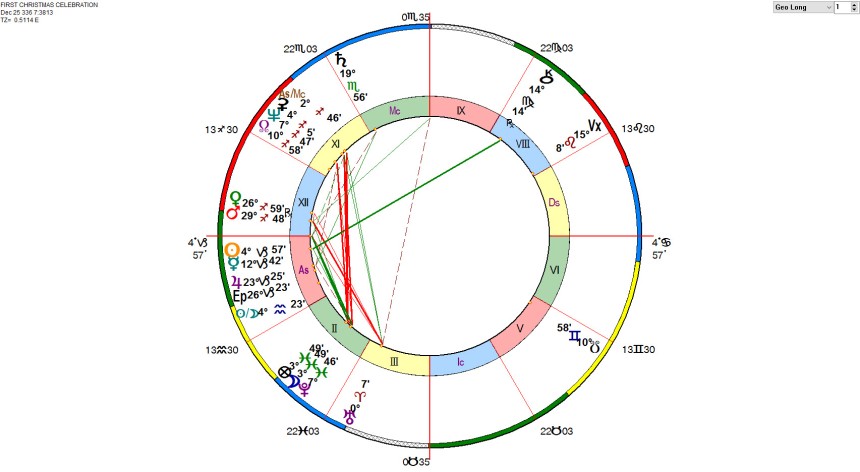

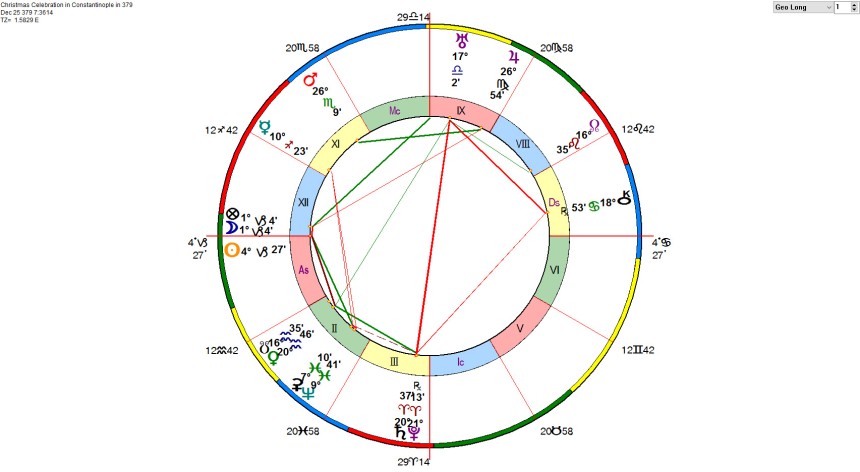
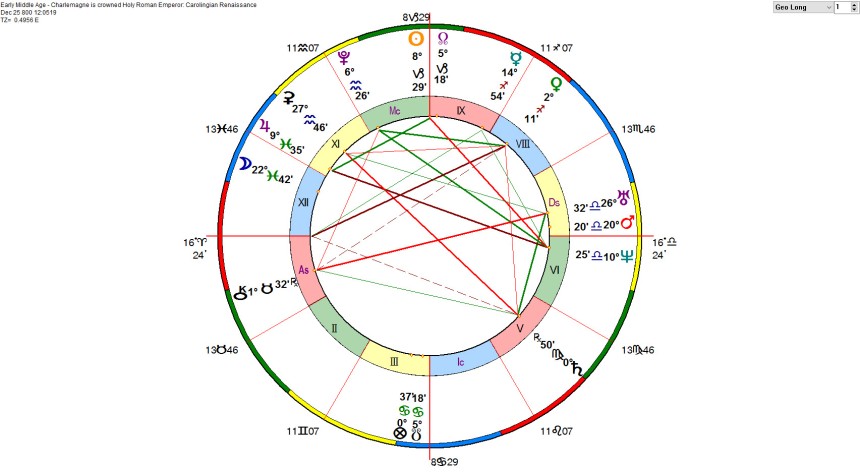
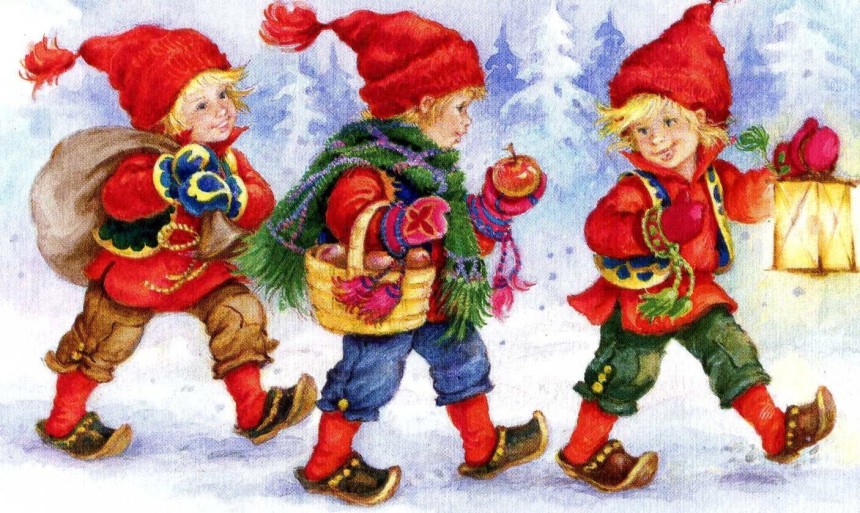






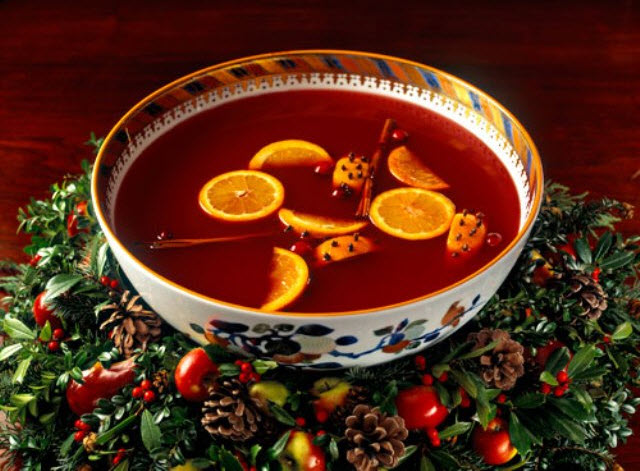
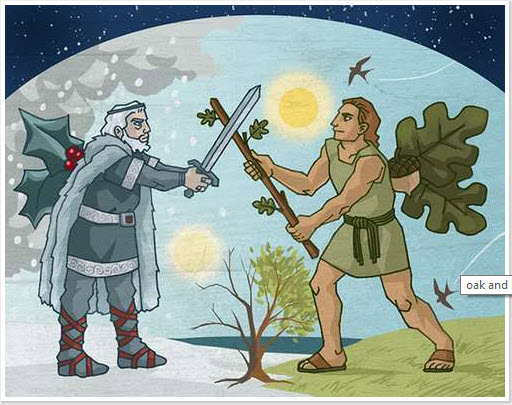
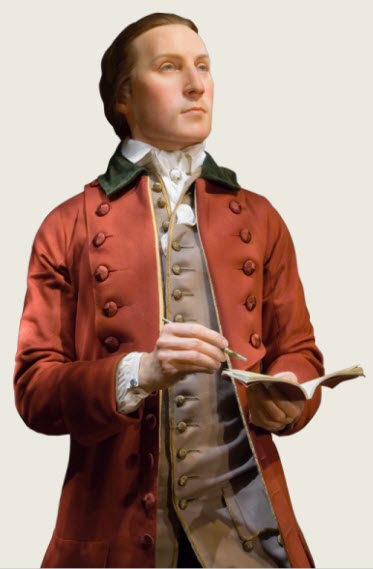
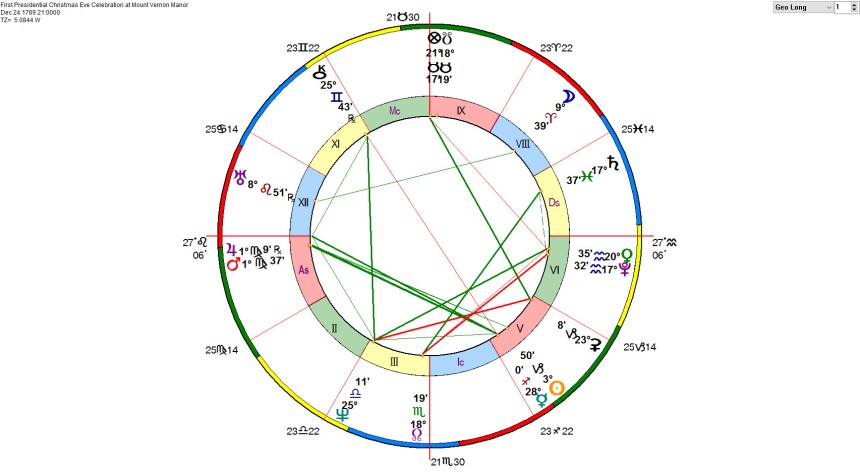
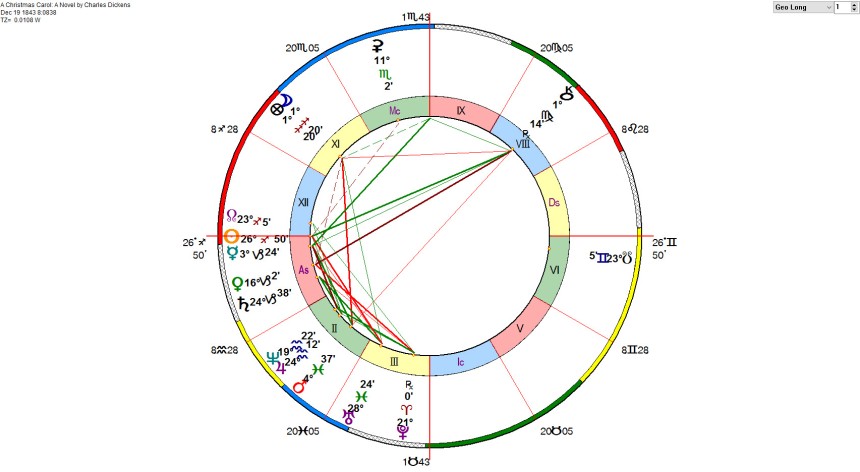
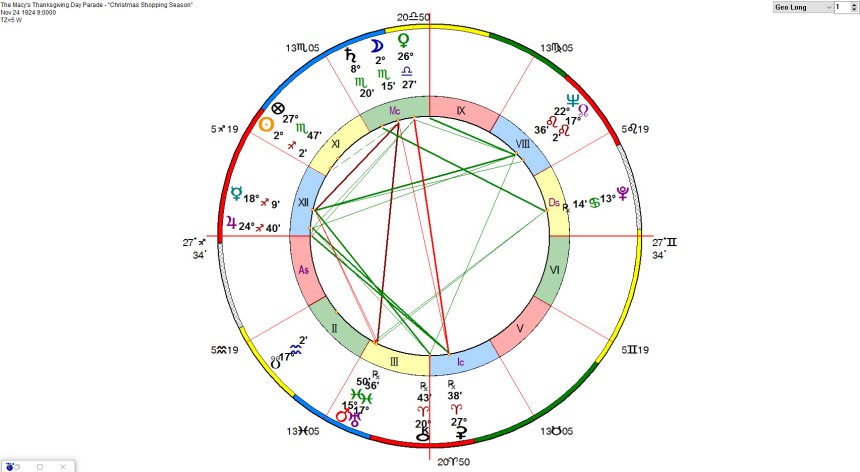
Thanx William. Need time to process this. My late dad, born 2/22/1922 effectively equal 22222 (equals 1 equals 10) has become a Astro-spiritual guide, even though while alive, hated astrology. If you add the 19, then it’s an 11. He liked to play craps… right up to the end. Just sharing this as per ur inspiration. Interesting work. Thanx. Will process and get back. Merry Xmas.
LikeLiked by 2 people
Very interesting insight my Jeffrey. Let me know any additional insight’s the article brought up for you. Your input is always welcome.
Happy Holidays!
LikeLike
Birth under an opposition retro mercury to Neptune Retro, a spiritual guide who should not make the same mistakes lived in a previous life.
The guide, the Jupiter cycle and Saturn conjunction with the North Knot,..
LikeLike
Wow! Excellent article….
LikeLiked by 1 person
Thank James!
LikeLike
Pingback: The First Christmas Celebration – 336 A.D. in Rome | WILLIAM STICKEVERS
Great article but I would love to know…how many eggs go into George Washington’s eggnog? I don’t see them listed.
LikeLike
12 Eggs.
LikeLike